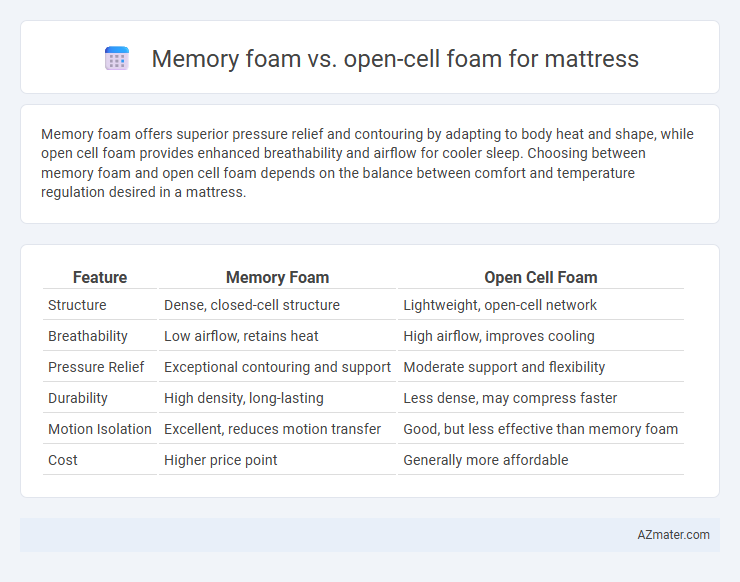Memory foam offers superior pressure relief and contouring by adapting to body heat and shape, while open cell foam provides enhanced breathability and airflow for cooler sleep. Choosing between memory foam and open cell foam depends on the balance between comfort and temperature regulation desired in a mattress.
Table of Comparison
| Feature | Memory Foam | Open Cell Foam |
|---|---|---|
| Structure | Dense, closed-cell structure | Lightweight, open-cell network |
| Breathability | Low airflow, retains heat | High airflow, improves cooling |
| Pressure Relief | Exceptional contouring and support | Moderate support and flexibility |
| Durability | High density, long-lasting | Less dense, may compress faster |
| Motion Isolation | Excellent, reduces motion transfer | Good, but less effective than memory foam |
| Cost | Higher price point | Generally more affordable |
Introduction: Understanding Mattress Foam Technologies
Memory foam features viscoelastic properties that adapt to body shape, providing pressure relief and enhanced comfort, ideal for sleepers seeking support and contouring. Open cell foam offers increased breathability and cooler sleep by allowing air to circulate more freely within the mattress structure, reducing heat retention. These distinct foam technologies influence mattress performance, durability, and temperature regulation, guiding consumer choices based on personal comfort preferences.
What Is Memory Foam?
Memory foam is a viscoelastic polyurethane foam designed to respond to body heat and pressure, providing enhanced support and comfort by conforming closely to the sleeper's shape. Unlike open cell foam, memory foam features a denser structure with closed cells that reduce airflow but improve motion isolation and pressure relief. This material's ability to mold to the body makes it a popular choice for mattresses aimed at minimizing pressure points and improving sleep quality.
What Is Open Cell Foam?
Open cell foam is a type of polyurethane foam characterized by its porous structure, allowing air to flow freely through the interconnected cells. This design provides excellent breathability and a cooler sleeping experience compared to denser foams like memory foam. Its lightweight and responsive nature offers good pressure relief and support, making it a popular choice for mattress comfort layers.
Key Differences Between Memory Foam and Open Cell Foam
Memory foam is a dense, viscoelastic material that contours closely to the body, providing superior pressure relief and motion isolation, while open cell foam features a network of interconnected air pockets that enhance breathability and airflow, reducing heat retention. Memory foam typically offers higher durability and a slower response to pressure, whereas open cell foam responds more quickly and feels less compressed due to its porous structure. The choice between memory foam and open cell foam in mattresses hinges on priorities such as temperature regulation, support level, and motion transfer.
Support and Comfort Comparison
Memory foam mattress offers superior contouring support by conforming closely to body shape, reducing pressure points and enhancing comfort for side and back sleepers. Open cell foam provides better breathability and a slightly firmer feel, promoting airflow and preventing overheating while maintaining moderate support. Memory foam excels in pressure relief and motion isolation, whereas open cell foam prioritizes temperature regulation and consistent support over prolonged periods.
Breathability and Temperature Regulation
Memory foam offers excellent contouring and pressure relief but often retains heat due to its dense, closed-cell structure, which limits breathability and can result in warmer sleep. Open cell foam features a porous structure that promotes airflow, enhancing breathability and temperature regulation by allowing heat and moisture to dissipate more effectively. Mattresses with open cell foam typically provide a cooler sleeping environment compared to traditional memory foam options.
Durability and Longevity
Memory foam mattresses typically offer superior durability and longevity due to their dense structure, which resists sagging and maintains shape over time. Open cell foam, while more breathable and cooler, tends to have a less resilient composition, leading to faster wear and reduced lifespan. High-density memory foam with closed cells provides consistent support and durability, making it a preferred choice for long-lasting mattress performance.
Motion Isolation and Noise Control
Memory foam excels in motion isolation by contouring closely to the body, effectively absorbing movement and minimizing disturbance between sleep partners. Open cell foam enhances breathability and temperature regulation but generally offers less effective motion isolation due to its more flexible structure. In terms of noise control, memory foam is virtually silent when compressed, while open cell foam may produce slight sounds under pressure, making memory foam preferable for noise-sensitive sleepers.
Price and Value Considerations
Memory foam mattresses typically have a higher price point due to advanced viscoelastic materials offering superior contouring and pressure relief compared to open cell foam. Open cell foam mattresses are generally more affordable and provide better breathability and airflow, enhancing cooling but with slightly less durable support over time. Evaluating long-term value, memory foam delivers enhanced comfort and durability justifying the cost, whereas open cell foam suits budget-conscious buyers prioritizing cooling and initial affordability.
Which Mattress Foam Is Right for You?
Memory foam offers superior pressure relief and contouring, ideal for individuals seeking support and motion isolation, whereas open cell foam provides enhanced breathability and airflow, suited for those who tend to sleep hot. Consider your sleeping position, body weight, and temperature preferences when choosing between the dense, slow-response memory foam and the lightweight, breathable open cell foam. Selecting the right mattress foam depends on whether you prioritize comfort and support or cooling and ventilation for a restful night's sleep.

Infographic: Memory foam vs Open cell foam for Mattress
 azmater.com
azmater.com